Catholic pilgrimage to the Holy Land in Israel/Palestine in 2008
Part 1 of 2
(Travel Story Series @ Hon Too Fang 2021)
A – Introduction
In April 2008 we joined a group tour to visit the Christian Holy Land in Israel/Palestinian Territories/Jordan organised by a Catholic church group in KL. As Malaysians are not allowed to visit Israel, as stated clearly in our passports, we had to apply for special permission to do so. In fact we were officially interviewed by an officer from the Special Branch to make sure we were true Christians going for a pilgrimage to Israel. The officer was most friendly and the interview carried out without any hitch for the group.
(Note in 2021: the tour was made in April 2008 and the 1st story was written only in June 2013. A lot has changed since 2013, like population figures and the political situations. The information presented here is that from the 2013 story. It is not updated.
Secondly the photos might be low in resolution and poor in clarity as the images from the 1st generation digital camera used in 2008 are of course of an inferior quality compared to what is available now, especially indoor shots in dimly lighted churches.)
A1 - The pilgrimage sites
The sites visited are places where our Lord Jesus has graced during his life on Earth some 2000 years ago according to the Gospels. Some of these places are now inside the State of Israel and some under the administration of the Palestinians.
A2 - Short info on Israel
The State of Israel was established in 1948 under a 1947 UN resolution though most of the Muslim countries in this World don't recognise the state. The original land area is about 20,770 sq km, only the size of our Perak state, though Israel also controls some territories captured from the neighbours during several wars fought since her formation. The captured territories include the Gaza Strip, the West Bank and East Jerusalem. The estimated 2012 population of Israel is about 8.0 million, 75% of them Jews. About 20% are Arabs. 80% of the Arabs are Muslims, the remaining are Arab Christians. Most Arab Christians are Greek Orthodox, we Catholics are a minority. And what is the religion of the Jews? Judaism of course, many sects, about 55% traditional, 20% secular, others Orthodox and ultra-Orthodox.
The official capital declared by Israel is Jerusalem but the UN and the international communities only recognise the capital at Tel Aviv. The official languages are Hebrew and Arabic. Yes, Arabic is an official language even though the Arabs are a 20% minority. The main industries are tourism, agriculture, and high-tech manufacturing.
A3 - Short info on the Palestinian Territories
These are Arab lands captured by the victorious Israel during the Arab-Israel wars. They are now under some kind of self-rule by the Palestinians while Israel still exerts military control over them. The main part, the West Bank comes under the self-rule of the Palestinian National Authority, while the other part, the Gaza Strip, comes under the control of the more militant group, the Hamas. The total area is about 6,220 sq km with an estimated 2012 population of 4.3 million. There are some 500,000 Israelis living in these territories, mostly in East Jerusalem and the West Bank. Those in the West Bank are mostly residents in new settlements established after 1947. There is not much of economy to talk about. The Palestinians depend on foreign aids to survive. Unemployment rate is more than 25%. Rock quarrying is the main industrial activity.
A4 - Understanding the historical era
In the description of the churches, it is often said that the new church was built over older Byzantine and Crusader churches. We need to understand the time period associated with these eras. The Byzantine Empire ruled over most of western Europe from the 4th to the 12th centuries. Crusaders were the Christian armies originally formed to re-take Jerusalem after it had fallen to the Muslims. There were 9 Crusades operating from 1,095 to 1,275.
A5 - Location of the first churches: myth or fact
On such pilgrimage we always wonder how sure are we that Jesus really stood on these places and preached 2,000 years ago. This is the location, sure? We have to turn to archaeological studies for help. Many of the first churches were built in the 4th century. Why so late as only in the 4th century? Because Christianity was outlawed by the Roman Emperors until 313. So official churches were built after 313. It is certainly not unreasonable to assume that prior to 313, the early Christians could be "secretly" venerating these sacred sites and put markers over them. In fact the Romans purposely built pagan temples over these sites to mock the Christians. The sites did not "suddenly" pop up after 313. So the locations should not be too far off.
At any of the sacred site there might be 2 or more churches, built by the different denominations, like Roman Catholic and Greek Orthodox. Usually they are very near to each other and might have the same name to commemorate the special occasion that happened on the particular spot 2,000 years ago. Since our group is Roman Catholic, we would visit mostly the Roman Catholic churches, or some churches under joint administration of the main denominations. Hence we call our pilgrimage a Catholic Pilgrimage and not a Christian Pilgrimage.
B - Religious places in the New Testament
The sequence of our tour of the sights follow roughly the life of Jesus, beginning with the incidence of the Annunciation and ending at his Death on the Cross.
B1 – Roman Catholic Basilica of Annunciation, Nazareth
Nazareth was the home town of Jesus where he spent most of his life until he started his mission work when he was about 30 years old. The present township of Nazareth is the largest city in north Israel. It is called the "Arab capital of Israel", as practically all the 40,000 residents are Arabs, 70% Muslims and 30% Christians. No Jewish presence.
According to the bible the angel Gabriel appeared to the Virgin Mary in her house and announced that she would conceive and bear the Son of God, Jesus. This event is known as the Annunciation. The first church said to be built over the house of the Virgin Mary was dated to around 340s. There were several rounds of re-construction of the church. The latest church is the Basilica of Annunciation built around 1960-69 and consecrated in 1969. It is the largest building in town. This is the parish church for the Catholics in Nazareth.
Bible reference: Luke 1: 30-31
But the angel said to her, “Do not be afraid, Mary; you have found favour with God. You will conceive and give birth to a son, and you are to call him Jesus”
Shown the main entrance at the west facade decorated with reliefs of Archangel Gabriel bringing the message to Mary and the images of the 4 authors of the Gospels. The next photo shows the carving of the main door, telling the life of Jesus.
Now the interior: first the central aisle and a very modern stained glass. The next 2 photos show a sunken part in the church housing the Grotto, said to be the cave-house where Mary received the message. And lastly more decorative elements, one with a very unusual style in the last photo.
Some of the walls within the church and walls in the courtyard are decorated with mosaics of the Virgin Mary donated by communities all over the World. Shown one each from Thailand, Japan and Indonesia, with the Virgin Mary in their respective "national" costumes. We couldn't find one from Malaysia.
B2 – Greek Orthodox Church of St Gabriel, Nazareth
The Catholic tradition says the Virgin Mary first saw Gabriel at a well where she was drawing water but received the message insider her house. The Eastern Orthodox tradition instead says Mary received the message right at the well. So the Greek Orthodox has a church built at this well site, their equivalent of the Roman Catholic Basilica of Annunciation. This small church was built in 1750 over an older Crusader church. It is lavishly decorated inside with icons and lamps, typical of Orthodox churches. The well is outside the church but the water source, called Mary's Spring, is inside the church. Shown the Sacred Spring. Like a wishing well with all the coins. This small church was packed with pilgrims.
(Note in 2021: so who is right on the location where the Virgin Mary received the message from the angel Gabriel? Inside the house or at the well? The Catholic or the Greek Orthodox? In fact both could be right. The Bible account does not specifically give the details of the location on the delivery of the message. But the Protoevangelium of James, a 2nd-century apocryphal text, states that the first part of the message was delivered at the well and the second part inside the house)
B3 - Greek Orthodox Church of St Joseph, Nazareth
This church, built in 1914 is located next to the Church of Annunciation. The place is said to be Joseph's carpentry shop. Well decorated with stained-glass windows. Shown a stained glass window and a statue of the Holy Family just outside the door.
These 3 churches are in fact located next to one another. Shown 2 shots on the common courtyard, one involving pilgrims from Africa.
B4 - Church of Nativity, Bethlehem
Bethlehem is a small town 8 km south of Jerusalem in the Palestinian-controlled West Bank. The population is about 30,000, Muslims outnumber Christians. The economy is almost entirely dependent on pilgrimage tourism because it is the place where Jesus was born.
The Church of Nativity here is Christendom's oldest working church. The first church was built in 339 by Emperor Constantine, dedicated to his mother Queen Helena, a long-time Christian. A larger church was rebuilt by Emperor Justinian in 565. The present church retains most part of the buildings constructed by Justinian. Over the years this church was spared destruction by the Muslims because in Islam, Jesus (Isa) is a revered prophet, though not the Son of God.
Bible reference: Luke 2: 4-7
So Joseph also went up from the town of Nazareth in Galilee to Judea, to Bethlehem the town of David….. While they were there, the time came for the baby to be born, and she gave birth to her firstborn, a son.
This extremely old church belongs to 3 church communities: the Greek Orthodox, the Armenians and the Roman Catholics. Each owns some parts of the buildings and each guarded their "possessions" selfishly. Shown the landscape of the area around the church. The trees are olives. The 2nd photo shows part of the external western facade where the main entrance is located. Buildings to the right belong to the Armenian Monastery, more details shown in the 4th photo. The main entrance opening is extremely low, aptly called the Door to Humility, where everybody needs to "bow" in entering. Shown also part of the interior, full of icons and lamps, and very old columns. The inside is very dark.
The most sacred place inside is the Grotto, said to be the birth place of Jesus. It is a cave-like place. The “exact” location is marked by a star installed in 1717. This is the Star of Bethlehem, belonging to the Roman Catholics. Above the Star inside the cave are 15 lamps, some could be seen in the photo. Out of these 15, 6 belong to the Greek Orthodox, 5 the Armenians and 4 the Catholics! Big crowd queuing to touch the floor or the star. Shown also a famous icon at the staircase leading to the cave.
B5 - Chapel of St Jerome, Church of Nativity
St Jerome was born around 340 in Croatia. In 386 he came to Bethlehem and stayed until his death in 420. He was a prolific writer and a great Bible scholar. His greatest achievement was translating the Bible from Greek (and Hebrew) to Latin, to be called the Vulgate. The Vulgate is the Catholic's authoritative version of the Bible until today. We had our daily mass at the Chapel of St Jerome, a very small cave decorated with mosaics. The 4 persons depicted in the mosaic are St Jerome and Bishop Paulinus of Antioch on the right and St Paula and St Eustochium. The 2 matrons were St Jerome's assistants.
B6 – Latin-rite Catholic Church of St Catherine, Bethlehem
This church is located next to the Church of Nativity and is the parish church of the Catholics in Bethlehem, numbering about 1,300. St Catherine of Alexandria was said to be a princess and a scholar from Alexandria, and was martyred around 310. The church was built at the place where Jesus appeared to her and foretold her martyrdom. Several churches stood here before. The present one was built in 1881. The statue in front is that of St Jerome. Shown an interior view of the church, showing one of the 3 aisles. The statue on the wall, 3rd photo, is that of St George, the patron saint of the Palestinian Christians.
The church belong to the Catholics, but not the Roman Catholics. The administrator of this Latin-rite church is the Latin Patriarchate of Jerusalem.
The celebration of Midnight Mass on Christmas Eve, televised to millions of viewers worldwide is conducted in this Church of St Catherine. You may wonder why not celebrated in the bigger and more appropriate Church of Nativity. Well, the main hall of the Church of Nativity belongs to the Greek Orthodox and they celebrate Christmas on 7th of January, not 25th of December.
World Heritage Site
The Nativity church complex, including the 2 churches mentioned earlier and other monasteries are a UNESCO World Heritage site.
B7 - Chapel of the Milk Grotto, Bethlehem
A short walk from the Church of Nativity is the Chapel of the Milk Grotto, built above a cave the Holy Family were said to be hiding before fleeing to Egypt during the Massacre of the Innocents by King Herod. Shown the beautiful decorations. A popular souvenir item here is the “milk powder” made from white limestone found here. There are many stories about women who could not conceive for years getting pregnant after taking the powder.
B8 - Chapel of the Angels, Bethlehem
The small Arab village of Beit Sahur, 1.5 km east of Bethlehem, is the place where Christian tradition says the angels appeared to the shepherds to announce to them Jesus' birth. It is called the Shepherds' Field.
Bible reference: Luke 2: 8-11
And there were shepherds living out in the fields nearby…..An angel of the Lord appeared to them…..’Do not be afraid. I bring you good news…..today in the town of David a Savior has been born to you; he is the Messiah, the Lord’
A modern Chapel of the Angels was built here in 1954. The building looks like a tent of the shepherd. Shown the chapel dome and a painting on the wall.
B9 - The Tree of Zacchaeus and the Church of Good Shepherds, Jericho
Jericho is a small town 40 km east of Jerusalem. It is 250 m below sea level, making it one of the lowest inhabited places on Earth. It is also a very old town.
Bible reference: Luke 19: 1-4
He entered Jericho and…..a man Zacchaeus made his appearance…..he was too short and could not see him for the crowd; so he ran ahead and climbed a sycamore tree to catch a glimpse of Jesus who was to pass that way.
Tradition says the sycamore tree is still standing, as shown. Fact or tourism hype? Up to you. Government sources reported that the 18-m tall tree has been scientifically tested to be over 2,000 years old. The 2nd photo shows our group buying strawberries from a street vendor near the tree. We attended mass at the Latin-rite Catholic Church of Good Shepherds, built in 1924, the small parish church to about 200 Arab Catholics in Jericho.
B10 - Mount of Temptation, Jericho
The Mount of Temptation was where Jesus was tempted by the Devil. The tradition started in the 12th century when the Crusaders built 2 churches on the cliff. The old name was Mount of Forty, the "forty" referring to the days Jesus spent in the wilderness. We went up the mount by cable car. There is an Orthodox monastery there, built in the 1880s. Shown part of the remains of the cave church built by the Crusaders, including the dome and an iconostasis (wall of icons) of the Orthodox monastery.
B11 - Boat cruise at Tiberias, Sea of Galilee
The Sea of Galilee is actually a lake between Israel and Jordan. There are many references on Jesus and the Sea of Galilee in the Bible. In fact Jesus recruited several of his disciples who were fishermen here, like St Peter. Tiberias is the biggest town on the shore, with a population of some 43,000.
We boarded a cruise boat at Tiberias and went to sea, a cruise to nowhere, hoisted our Malaysian flag on the boat too. A cool morning and a calm sea but no one dared to go for a walk (on the water) as Jesus did nearly 2,000 years ago. Shown a boat of tiring passengers and a mini group photo with our accompanying priest, Father Frederick Joseph.
We later had lunch at a Lebanon restaurant and the main course was grilled St Peter's Fish, the most common fish living in the Sea of Galilee. And you know what, St Peter's Fish is in fact our cheap tilapia, a very hardy fish.
B12 - Roman Catholic Church of the Multiplication, Tabgha
Tabgha is a village off the shore of the Sea of Galilee. It is considered the place where Jesus performed the miracle of multiplication to feed 5,000 people with just 5 loaves of bread and 2 fishes.
Bible reference: Mark 6: 41-44
Taking the five loaves and the two fish and looking up to heaven, Jesus gave thanks and broke the loaves. Then he gave them to his disciples to distribute to the people. He also divided the two fish among them all. They all ate and were satisfied, and the disciples picked up twelve basketfuls of broken pieces of bread and fish. The number of the men who had eaten was five thousand.
A small chapel was said to be erected here in the 4th century. The present church was consecrated in 1982, built over a Byzantine church completed in the late 5th century, retaining many of the old design features. On the floor are restored mosaic pieces dated to the late 5th century, including a famous piece with 2 fishes and loaves of bread. These mosaics are among the oldest in the Holy Land. The most important relic is the dark limestone below the altar, said to be the one where Jesus placed the loaves and the fishes.
B13 - Roman Catholic Chapel of the Primacy of St Peter, Tabgha
Close to the Church of Multiplication and closer to the shore of the Sea of Galilee is the Chapel of the Primacy of St Peter, belonging to the Franciscan order. Tradition has it that this was where Jesus appeared to the disciples after his Resurrection and he commissioned St Peter to “feed my sheep”.
Bible reference: John 21: 9-17
As soon as they came ashore they saw that there was some bread there and a charcoal fire with fish cooking on it….Jesus said to them, 'Come and have breakfast'….Then he said to him a third time, 'Simon son of John, do you love me?'…..Peter said, 'Lord, you know everything; you know I love you.' Jesus said to him, 'Feed my sheep'.
Shown with fellow pilgrim ST. The statue outside the chapel depicts the appointment of St Peter as head of the church. There was then an outdoor mass being said, not our group though. The stone inside the chapel is said to be the “Mensa Christi” or “Table of Christ” upon which Jesus prepared breakfast for the disciples. Shown also the elaborate relief on the cast-iron door.

B14 - Roman Catholic Church of Beatitudes, near Tabgha
According to traditions the Mount of Beatitudes near Tabgha was where Jesus delivered his "Sermon on the Mount". A church was built here in the 4th century. The present church was built in 1937 next to the old church but not over it. The floor plan is octagonal, the 8 sides representing the 8 beatitudes. At the time of our visit there was a mass being celebrated with many priests. Shown part of the pavement mosaic, too elegant to be stepped on.
B15 – Roman Catholic Church over St Peter's House, Capernaum
Capernaum, off the shore of the Sea of Galilee, was the home town of St Peter. The town was destroyed by the Arabs in the 7th Century. It remained a wasteland until 1891 when the Franciscans bought over the land. An extensive excavation project was commissioned. It is now a vast archaeological site. A simple one-room-church dated to the 1st century was discovered, together with a group of houses. One of the houses was “determined” as belonging to St Peter, buried underneath a Byzantine church.
A new church was built (elevated) over the old house in 1990. We celebrated mass here. Shown an internal view of the bright and airy church, and carving on a column and a statue of St Peter in the courtyard, holding a Shepherd’s Staff representing his role as chief shepherd of Jesus’ flock.
(Note in 2021: the 1st photo was taken from the internet, photo credit: dreamstime.com. My own photo was found corrupted.)
Next to the church are the ruins of an old synagogue dated to the 4th or 5th century, built to replace the synagogue in which Jesus has taught.
B16 – Roman Catholic Church of the Wedding Feast, Cana
Bible reference: John 2: 1-11
On the third day there was a wedding at Cana in Galilee…..And they ran out of wine…..Jesus said to the servants, 'Fill the jars with water,'…..The president tasted the water, and it had turned into wine…..Jesus did this, the first of his signs, in Cana of Galilee, and revealed his glory; and his disciples believed in him.
Cana, just outside Nazareth, is the place where Jesus performed his first miracle: turning water into wine. Where is Cana? The exact location has been subjected to debate for a long time. Scholars opined that the most likely location is the Arab town of Kafr Kanna. The first church was built, like many other churches, in the 4th century.
The present church was built in the 19th century over older Crusader and Byzantine churches and last renovated in 1999. Shown the main façade, accompanied by 2 Franciscan monks, the main altar and a section with preserved ruins of the Byzantine church.
Couples walked into the church in pairs, old brides given flowers, exchanged vows and were “re-married” by the priest celebrating the “wedding mass” and were later given mock marriage certificates. Of course we had a small wedding feast after that with wines produced in this region. That is religious tourism.
B17 – Roman Catholic Church of the Transfiguration, Mount Tabor
Mount Tabor is 18 km west of the Sea of Galilee. It is an isolated hill about 575 m in elevation.
Bible reference: Luke 9: 28-29
He took with him Peter, John and James and went up to the mountain to pray. And it happened that, as he was praying, the aspect of his face was changed and his clothing became sparkling white.
The name of the mountain was not mentioned in the Bible. Nevertheless Mount Tabor was traditionally identified as the place of Jesus' transfiguration. Early church elders Origen, St Cyril and St Jerome all mentioned this Mount Tabor as the mountain. According to accounts of pilgrims, there were already 3 churches built here by the 6th Century. The present church was built in 1924 together with a Franciscan monastery.
Shown the front facade of the church, praying at a chapel, a mosaic piece and another decoration. Shown also ruins of the earlier Byzantine church and a shot of the surrounding lowland viewed from the mount.
B18 - The Stella Maris Church on Mount Carmel, Haifa
Mount Carmel is actually a coastal mountain range in northern Israel fronting the Mediterranean Sea. Haifa is a modern harbour city on the lower slope of this mountain. Haifa is the 3rd largest city in Israel, after Jerusalem and Tel Aviv.
The 1st photo shows part of the city view from the mid-level of Mount Carmel. The last photo shows the Baha’i World Centre, a UNESCO World Heritage site. We did not visit the Baha’i World Centre as we were not allowed to under the terms and conditions of approval from our Malaysian government for us to visit Israel. We were allowed to visit only Christian sites. The photo was taken at a photo stop by the road.
In the Old Testament, Prophet Elijah fought against the priests of Baal near the south-eastern peak of Mount Carmel. There is a huge statue of him here. Shown also a fellow pilgrim at the chapel of the Carmelite monastery located beside the statue.
The Carmelites is a Roman Catholic religious order established in Mount Carmel in the 12th century. The current monastery complex, located on the slope of Mount Carmel, was completed in the 1930s. The monastery serves as the World HQ of the Carmelites. The main church here is the Stella Maris Church. “Stella Maris” is “Star of the Sea” in Latin, a reference to the lighthouse here. The most notable image here is the Blessed Virgin Mary holding the infant Jesus in one hand (or lap) and the scapula in the other hand. The Image is known as Our Lady of the Scapula. The scapula is a sacramental garment, like an apron.
The circular church is topped with a beautiful painted dome. It illustrates, among other things, Elijah elevated to heaven in his chariot, 1st photo. We had our daily mass here, said by Father Frederick. The 3rd photo shows Our Lady of Scapula as an embossed image on the door. The 4th photo shows a plaque to honour St Edith Stein, a German Jewish philosopher and Carmelite who died at the Auschwitz concentration camp in 1942. Our spiritual director, Father Frederick stood among the palm trees and the monument of the Madonna at the East Entrance. And lastly a parasitic plant in bloom.
B19 – Roman Catholic Church of St John the Baptist, Ein Karem
Ein Karem is an Arab village just west of Jerusalem. It is traditionally associated with the home of Zachariah and Elizabeth, the parents of St John the Baptist. The Virgin Mary’s visit to her cousin Elizabeth is also commemorated here. The 2 famous churches here are the Church of St John the Baptist, and the Church of Visitation. We visited only the first one.
Shown a statue of St John. There are 24 tile plaques on the walls in the courtyard, and on each of these, in different languages, is written the famous prayer “Benedictus” said to consist of the first words uttered by Zachariah after the birth of his son. Shown Father Frederick in front of the English version and a Chinese version.
B20 - The Roman Catholic Crusader Church at El-qubeibeh (Emmaus)
Luke’s Gospel recalls that on the day of the Resurrection, Jesus appeared to 2 of his disciples at the village of Emmaus, said to be not far from Jerusalem. The exact location of Emmaus is unknown. The village of El-qubeibeh, about 10 km north-west of Jerusalem, is one of the sites linked with the old Emmaus. The present church was consecrated in 1902 by the Franciscans. Remains of the old Crusader church, including murals, could be found at the crypt.
In the garden at the courtyard, flowers are in bloom, like the pansy, a hybrid viola. Shown with fellow pilgrim and old friend Lena.
(Note in 2021: For a long time there have been 4 places being considered as the village of Emmaus mentioned in the Bible. This village of El-qubeibeh is not the highest ranked. Firstly it has never been called Emmaus or similar in its history, and secondly it first appeared to be considered only around the 12th century, the time of the Crusaders. A place called Colonia, nearer to Jerusalem, is now being considered more likely.)
B21 – Roman Catholic Church of St Lazarus, al-Eizariya (Bethany)
The village of al-Eizariya on the West Bank, or Bethany as the name used in the Bible, just east of the Jerusalem suburb, is generally associated with the place where Jesus’ friends: Martha, Mary and Lazarus lived. The best known gospel scene associated with Bethany is Jesus’ rising of Lazarus from the dead. The place has been venerated as a sacred site since the 3rd century.
Bible reference: John 11: 38-44
Sighing again, Jesus reached the tomb: it was a cave with a stone to close the opening. Jesus said, 'Take the stone away' ….Then Jesus lifted up his eyes and said: Father, I thank you for hearing my prayer…..When he had said this, he cried in a loud voice, 'Lazarus, come out!' The dead man came out, his feet and hands bound with strips of material, and a cloth over his face.
The present church was built in 1954 incorporating features of remains of older churches. There are many pieces of large murals here, shown one with Jesus raising Lazarus from the death. Shown Father Frederick saying mass, a chapel in the older church and a millstone.
*** End of Part 1 of 2 ***




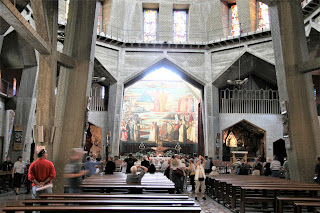



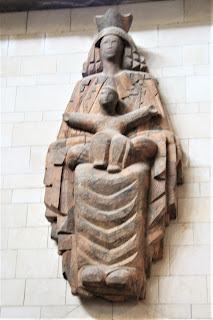


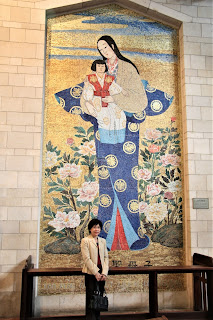





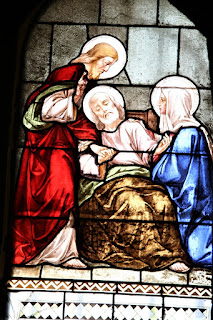











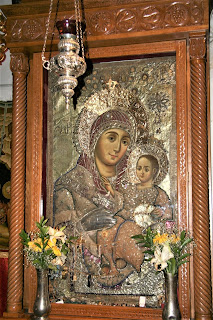





















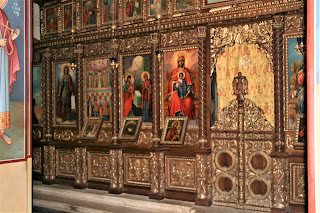




















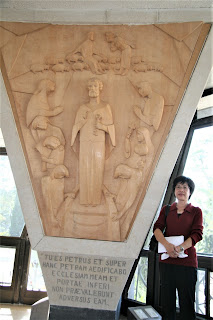















































No comments:
Post a Comment